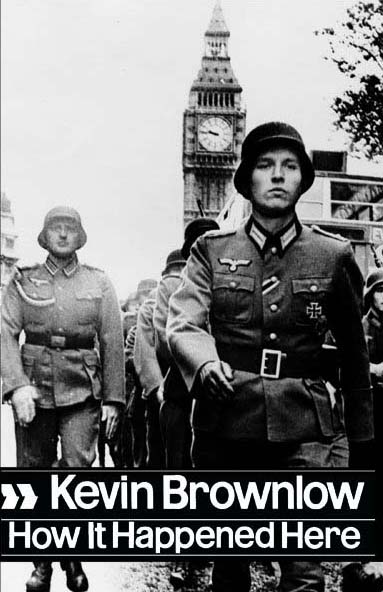|
This is the story of the making of a film called It Happened Here. I
know that few of you will have heard of it and there is a reason for
this. The film was the part–time project of two teenage boys back in
the 1960s, and it took them eight years to see it through from its
conception as an idea to the film’s brief national release in 1966.
Because of the controversy it stirred – up it was effectively suppressed
by the entire movie industry, including its own distributor. In order to
have it released at all the two young co-Directors were required to
agree to the cutting of a six-minute sequence that the distributors
United Artists regarded as simply too hot to handle.
The ultimate blue movie? Only in a very special sense. Had it
contained explicit sex scenes its censorship and suppression would
have been far simpler for the guardians of public taste and morals.
This was a film about the epidemiology of Fascism. How the disease
takes hold and how it spreads and what it does to the minds of those
it infects. And in dealing with this subject matter the film-makers
dared to suggest that the British people were no different to any
others, that Fascism is not some alien foreign import but an ever-
present dark undercurrent in human nature itself.
Hitler has taken over from the Devil as the icon of evil in the West,
and this is understandable. The Holocaust truly represented a new
trench dug at the bottom of the cess-pit of human behaviour. It was
the first attempt at the industrialisation of murder. The philosophy of
Henry Ford applied to the task of terminating human life. But the
symbolism of a Devil, a Hitler or an Eichmann is also an effective way
of convincing ourselves that the people who did those things weren’t
the same as us. They were out there somewhere, foreigners, fanatics: the bogey-men and monsters that we fought in history’s one unassailably
Just War – and we won! How often has this assumption of the
‘otherness’ of the Fascist been questioned in art or literature? Hardly
at all I would suggest. The Fascist, the Nazi, is the Villain of the
morality play, his mental processes unfathomable, his evil absolute.
He is simply a cipher to be overcome by the people we identify with,
the ones who represent ourselves.
Leonard Cohen called this view into question in his poem All There Is
to Know about Adolf Eichmann. First he tells us how ordinary
Eichmann was: average height, average weight, average intelligence,
no distinguishing marks. Then he hits us with the killer final stanza:
What did you expect? Talons? Oversize incisors? Green saliva?
Madness?
Kevin Brownlow and co–Director Andrew Mollo took this a stage
further and tried to show us exactly how the ordinary person of
average everything turns into the nurse administering the lethal
injections in the genteel rural euthanasia mill. This is shown to be a
process not so much of intellectual conversion as of resignation and
conformity to the role that society allocates. The film confronts each
viewer with the question: What would I have done? It personalises the
spread of the twentieth century’s most toxic political ideology.
Essentially it holds up a mirror and asks us to look at ourselves, which
is exactly what should be going on when art, particularly narrative art
like film, literature and theatre, is doing its job.
The book describes the evolution of the boys’ thinking as they solved
the seemingly impossible technical problems of creating a feature
film without finance, backing or even very much time, enlisting the
help of friends, acquaintances and kindly strangers, borrowing a
camera (which was almost immediately stolen) and visiting flea
markets to buy old German tunics and Nazi regalia.
The original idea was to tell the story of a hypothetical German invasion of England
following the Dunkirk retreat, leading to a period of occupation and
partisan activity, and ending with the country’s liberation by
American troops in the closing year of the war. A counter-factual war
adventure, with lots of battle scenes and heroics. But as the boys
learned more about Fascism, met committed British Fascists like
Frank Bennett, and began to think about what occupation really
meant, the film departed from its Boys’ Own beginnings to become
something far darker and more significant: a portrait of a Fascist
England that might have been, presented with a narrative distance
that was later to be mistaken by some for approval.
This is a many-layered book, partly the personal testament of a filmmaker who believes that his work has been misunderstood, partly a
technical notebook about how (and how not) to make a film, partly a
glimpse inside the power-politics of the film industry, partly an
account of the actual events surrounding the film’s release and the
reactions of press, actors’ unions, early audiences and the Board of
Deputies of British Jews.
Most of all though it is an account of what it
is that drives an artist to create and the constraints that operate
even in the most liberal of Western democracies on what the artist is
allowed to say. It’s also inhabited throughout by the dry wit and stoic
humour of the author, and if all that isn’t enough it contains more
than one hundred photographs, mostly (though not all) stills from the
superb, chilling film they eventually created.
Even if you aren’t particularly a film buff or student of twentieth
century politics, indeed even if you can only afford to buy one book
this year, I recommend without qualification that you should make that one book How It Happened Here.
The film itself is available on DVD and Video from MovieMail and of course Amazon.
SEND ME AN EMAIL 
|












